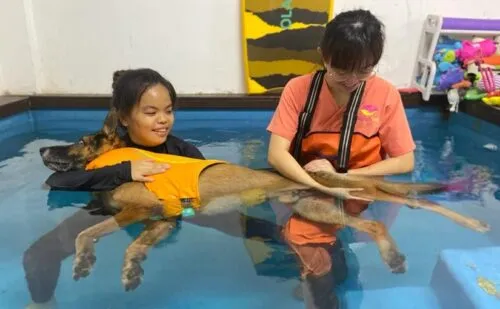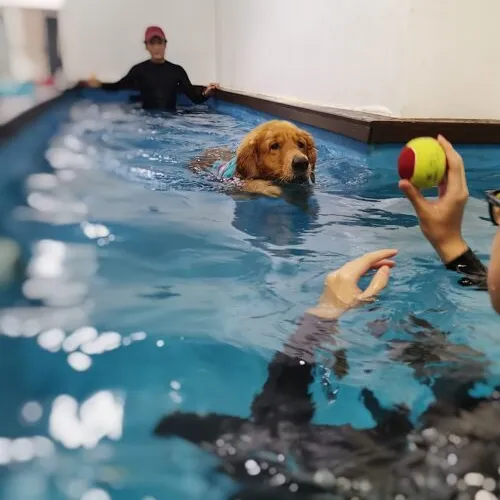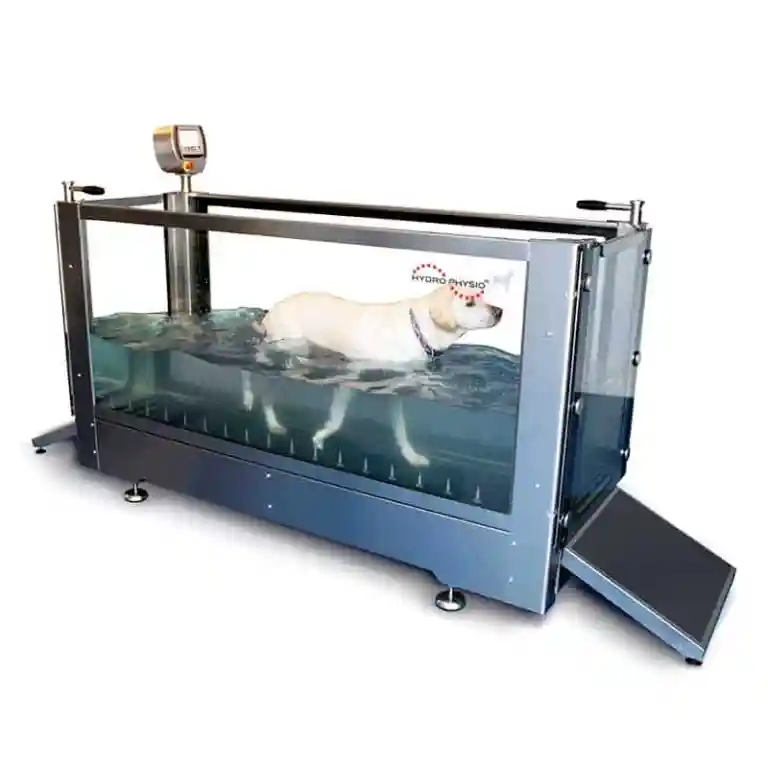EXCELLENTTrustindex verifies that the original source of the review is Google. Shout-out to the dedicated team for their attentiveness and patience. Today is Kobi's 3rd hydrotherapy sessions, and am happy to see that he's taking well to it, albeit the slight hesitation (and nervousness) in the beginning. Keeping my fingers crossed that the sessions will help improve and maintain his mobility/fitness and attain a healthy weight 😊Trustindex verifies that the original source of the review is Google. My dog Barley hind leg limping for months. Saw vets and said arthritis. Treated with pain killers but no improvement. My dog has heart failure and medications made her conditions worsen. I googled it to find dog acupuncture services and found Rehabvet. Underwent for assessment and started laser treatment for pain. I noted my dog felt better straight away and I signed up for rehab package. Rehabvet team is very caring and well experience in rehabilitation of dogs. I recommend Rehabvet services for dogs owners who need rehabilitation or pain management of their dogs.Trustindex verifies that the original source of the review is Google. TDLR: Saw alot of improvement on my dogs weak legs in just 10x 1-hour sessions, defo worth every penny imo. My dog came in with a very common issue of hip dys + luxating patella and as an owner, i've already exhausted majority of the options out there, including visiting a ortho specialist. As I'm against the idea of any invasive surgery, i decided to give rehab a try first. throughout all 10 sessions, i never ever felt rushed even on days when i had more questions or when her sessions exceeded the 1 hour mark/ the hour they're closing. despite the many pets that they go through in a day, i always felt they were genuine and never saw clients as their 'moneypot'. As my dog is reactive towards other pets, the staff never fail to accommodate and try to find me a room for us to wait in. All in all, i can say that my dog's posture when standing is alot better, hind legs are alot stronger than before, also limps alot lesser right now. but at the same time, owner also has to put in the effort and walk/ exercise on the other days of the week. this is no miracle work if you don't play your part 🤣 All the staff are always so gentle when handling her, she would have definitely slept during the sessions if she wasn't an anxious doggy.Trustindex verifies that the original source of the review is Google. Mantou started his rehab journey with random trembling in his hind legs. Through the sessions, we understood the root cause of the issue and how it affected him as a whole. We started on a treatment plan to heal and strengthen Mantou's muscles. Apart from getting lots of sayangs, treats, and massages, Mantou also gained confidence in swimming during his sessions. Both the hoomum and Mantou learned and practiced exercises that are beneficial to Mantou's condition and help strengthen what was lacking. We walked away not only with a stronger and more well-built Mantou but also with the knowledge to maintain and continue his progress. 10/10 would recommend the team at Rehab Vet for their dedication and care!Trustindex verifies that the original source of the review is Google. Having been to several vets and rehabs with my senior Shih Tzu, my experience at RehabVet has been the best. My only regret was not bringing him here sooner when his issues first came up! My very anxious 15 year old kiddo was diagnosed with IVDD and is unable to move all his limbs voluntarily at all times. It was a very sudden event and both of us were under lots of stress. We WhatsApp-ed the team and got an appointment promptly. After the initial testing and diagnosis by Dr. Sara, he has had a few trips to the Hyperbaric O2 Therapy, Laser Therapy, and Electrical Stimulation with massages. Now, I can tell that he is in less pain and is also more comfortable and less anxious. Xan always handles him with so much care so I feel very assured when I leave my kiddo with him and the specialists there. He also takes the time to teach me how to perform home therapy. I can see and feel that Dr. Sara, Xan, and the team there truly cares about helping each and every doggy (or kitty)! I would highly recommend RehabVet to anyone thinking about it!Trustindex verifies that the original source of the review is Google. We are truly thankful for what Rehabvet has done for many of our shelter dogs - hock Lai (spinal injury and FHO on left leg), nugget (patella luxation and hunch back, weakness on both hind and in a lot of pain), Eden (ACL injury), keeper (arthritis), jay jay (arthritis) and more. They never fail to amaze us with the results. When we lose hope, miracle appears! They treat singapore special the same way they treat other dogs. No prejudice and totally invested to see them improve every session. Thank u Dr Sara, Angeline, Joyce and everyone involved !Trustindex verifies that the original source of the review is Google. very patient and knowledgeable staffsTrustindex verifies that the original source of the review is Google. We’ve been with the Rehab Vet team for nearly half a year now, and they’ve been absolutely amazing. The team is not only knowledgeable but also incredibly kind and accommodating. Both my Singapore Specials have been so well cared for, even though only one of them requires the service. Their genuine dedication and warmth have made every visit a positive experience. Thank you for all that you do, and keep up the fantastic work, team!Trustindex verifies that the original source of the review is Google. I can't thank Xan and his team at RehabVet enough for the incredible care they've given my dog. After a sudden incident where my dog started dragging both hind legs, the vet diagnosed him with IVDD stage 2. The animal hospital quoted me a huge amount for a CT scan and surgery, and I wasn't sure if I wanted to put my senior dog through that. I decided to try physio at RehabVet, and it was the best decision I could have made. Within just 2-3 sessions, my dog's hind legs showed significant improvement—they were no longer wobbly. Now, after 7-8 sessions, he's regained his mobility and is even jumping around at home again. Xan's patience and dedication made all the difference. He provided thorough treatment during each session, and my usually anti-social dog felt comfortable and happy around him. Unlike other experiences I've had, Xan always gives my dog his full attention and care, making sure each session is truly effective. Every session I just leave my dog with him and can have some me time while trusting that my dog is in good hands. They even send me pictures of my dog during the treatment to keep me updated and provide specific instructions on exercises I can do with my dog at home until the next session. I highly recommend RehabVet to anyone in need of compassionate, effective care for their pet. 👍🏻👍🏻👍🏻Verified by TrustindexTrustindex verified badge is the Universal Symbol of Trust. Only the greatest companies can get the verified badge who has a review score above 4.5, based on customer reviews over the past 12 months. Read more
Hydrotherapy is a gentle yet powerful natural therapy for dogs. It can help with post-surgery recovery, long-term health conditions, or simply maintaining your pet’s overall fitness.
Why Choose RehabVet?
At RehabVet, we focus on your dog’s individual needs. We offer one-on-one hydrotherapy sessions, ensuring every dog gets the careful attention they deserve in a safe, comfortable setting.
How Does Hydrotherapy Work?
Why Warm Water Matters
Warm water encourages blood vessels to expand, boosting circulation. It also helps muscles become more flexible, improving your dog’s range of motion.
Our Holistic Approach
At RehabVet, we believe in looking after your dog’s overall well-being. While hydrotherapy has many benefits, it should be paired with regular on-land activities, like walking or running on padded surfaces, along with a balanced diet. This complete approach ensures your furry friend stays happy and healthy.


Reduces Stress on Joints
The buoyancy of water supports your dog’s body weight, easing pressure on joints and helping them move more comfortably.
Builds Muscle Strength
Water provides natural resistance, encouraging muscles to work harder without risking injury—ideal for dogs needing muscle rehabilitation or increased tone.
Enhances Flexibility and Range of Motion
Warm water relaxes stiff muscles, allowing joints to move more freely. This is especially beneficial for dogs with arthritis or post-surgery stiffness.
Improves Blood Circulation
The warmth of the water dilates blood vessels, promoting better blood flow to muscles and tissues for faster healing and recovery.
Alleviates Pain and Inflammation
Gentle exercises in warm water can reduce swelling and pain, helping dogs recover faster and feel more at ease.
Promotes Safe Rehabilitation
Hydrotherapy is a controlled environment, making it a great option for dogs recovering from surgery or injury, minimising the risk of further harm.
Aids in Weight Management
Swimming and water exercises burn calories without putting excessive strain on joints, making hydrotherapy an excellent tool for weight control.
Provides Gentle Exercise for Seniors
Older dogs often face mobility issues and chronic pain. Hydrotherapy offers a low-impact workout that keeps them active and comfortable.
Boosts Overall Fitness
Regular sessions help maintain healthy muscle tone, improve endurance, and support overall cardiovascular health for dogs of all life stages.
Encourages Mental Well-Being
Warm water and gentle handling can help relieve anxiety or stress. A supportive environment builds confidence and can even improve a dog’s mood.
Post-Surgery Rehabilitation
Joint and Mobility Issues (e.g., Arthritis, Hip Dysplasia)
Chronic Pain or Inflammation
Neurological Disorders (e.g., Intervertebral Disc Disease, Nerve Injuries)
Weight Management or Obesity
Muscle Weakness or Atrophy
Orthopaedic Conditions (e.g., Cranial Cruciate Ligament Injuries)
Senior Dogs with Reduced Mobility
At RehabVet, each 45-minute hydrotherapy session is specially designed to match your dog’s health needs. We combine physical therapy and gentle massage so your pet gets the most out of every session. Whether your dog has a mild or serious condition, our hydrotherapy plans are fully customisable.
Before starting, we review your dog’s detailed medical history—from you and your vet—to understand their condition better. This helps us create a targeted plan to manage their health and improve their overall well-being. After every session, we record their progress and note any improvements, making sure we keep a close eye on your pet’s recovery.
Gentle and Safe Introduction to the Pool
Our skilled hydrotherapists begin by introducing your dog to the water carefully, guiding them around the pool to help them relax. During the session, we watch over your pet closely, showing them how to use the right muscle groups and giving them rest when needed.
Safety First
Every dog wears a life jacket for added safety and easier handling, ensuring they feel secure while they exercise.
Rebuilding Strength and Well-Being
Hydrotherapy is an essential part of canine fitness. It helps strengthen weak muscles, boost overall health, and can be customised to meet your dog’s unique needs. Short-term sessions—like those for minor surgery recovery—may only require about six appointments. For dogs with chronic conditions, hydrotherapy can be a long-term or lifelong part of their care plan.
IThis non-invasive therapy involves using water to help dogs recover from injuries, surgeries, and other health conditions. During a hydrotherapy session, there are a few things you should expect:
1. Warm-up exercises: Before the actual therapy begins, your dog will undergo some warm-up exercises to help them get comfortable with the water. This could include walking on a treadmill or swimming in a shallow pool.
2. Special equipment: You should expect to see some special equipment used during the session, such as harnesses, life jackets, and water treadmills. These tools are designed to help your dog move freely and safely in the water.
3. Different water depths: Depending on your dog’s condition, the therapist may vary the water’s depth. Shallow water is ideal for dogs with mobility issues, while deeper water is better for those who need more resistance.
4. Low-impact exercises: During the session, your dog will perform low-impact exercises to help them build muscle strength, improve flexibility, and increase circulation. These exercises could include swimming laps or walking on an underwater treadmill.
5. Monitoring by a therapist: Throughout the session, a trained therapist will be monitoring your dog’s progress, adjusting equipment, and providing support as needed. They will also keep track of your dog’s vital signs, such as heart rate, breathing rate, and body temperature.

Hydrotherapy may not be suitable for dogs with certain conditions such as infectious diseases, serious heart or lung disease, open wounds, or certain skin conditions. Always consult with a veterinary professional or a certified hydrotherapist to assess each dog’s suitability.
Yes, but often times the condition affecting the animal can become worse from improper exercise routines. The underwater treadmill is a controlled exercise environment where walking speed, water temperature and water depth can all be controlled. The patient may also be given adequate rest periods if they are tired, facilitating optimal conditioning or appropriate rehabilitation from an injury. The therapist also helps to adjust therapy sessions based on how the patient is doing.
Most patients participating in aquatic therapy are already out of shape and swimming in a pool or lake requires more cardiovascular strength and endurance than is available.
Swimming in a hydrotherapy pool may be effective for some conditions, but again several factors are unable to be controlled during a free swim.